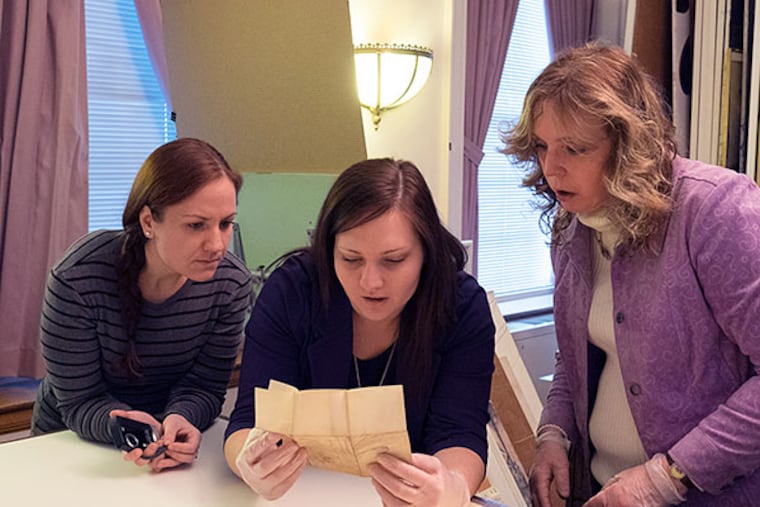Old letters shed new facts about Coatesville's history
The messages the company received were the usual sort. A few impatient customers asked the company to speed up their orders. One paid off a bill. Another apologized for not having the money just yet.

The messages the company received were the usual sort.
A few impatient customers asked the company to speed up their orders. One paid off a bill. Another apologized for not having the money just yet.
One message demanded the company pay money it owed.
What makes the messages unusual - and precious - are the dates on the letters, 1834, and to whom they were addressed, the family of Rebecca Lukens, the nation's first female industrialist.
"We're all aquiver because this [letter] was to Rebecca," said Kathy Bratton, collections manager at the National Iron & Steel Heritage Museum in Coatesville. "And to have the letters she handled is the holy grail."
Two weeks ago, restoration workers found about 20 folded letters or fragments of letters among a trove of artifacts tucked away in a wall of Rebecca Lukens' Coatesville home, the historic Brandywine Mansion. Museum workers opened most of the letters for the first time on Friday.
In the 1800s, Lukens ran the Brandywine Iron Works & Nail Factory, which became the Lukens Steel Co.
The company supplied iron plates for the first metal-hull vessel built in the United States, according to the museum. It also made steel beams used to build the World Trade Center's twin towers.
The letters requesting products from the company are particularly exciting, museum workers say. Employees hope the orders will point to other historically significant uses of the company's products. They plan to cross-reference the letters with account books.
During the 1820s and '30s, the factory was going from producing nails, wagon-wheel supports, and barrel hoops to making iron plate. It eventually switched to steel with the changing times.
Fifteen letters were written in the spring and summer of 1834. They are intact and wonderfully preserved. Rats or mice got to a few of the others.
The oldest letter, dated 1814, is too riddled with holes from acidic ink to read. At least one letter refers to the Philadelphia and Lancaster Turnpike, now known as Route 30.
"What a great find," said Lois Olcott Price, a conservation director at the Winterthur Museum, Garden & Library near Wilmington. "A great find and an exciting story."
She helped the Coatesville museum analyze some of the letters.
The missives are addressed to Rebecca Lukens, who took over her father's iron factory; to her husband, Charles; and to Solomon Lukens, Rebecca Lukens' brother-in-law, who helped her run the company after her husband died in 1825.
Philadelphia; Wilmington; Beaver, Pa.; New Brighton, Pa.; and Albany, N.Y. are among the places the letters originated.
Among the letters from business partners is one from Rebecca Lukens' younger brother, George Pennock, asking to borrow some bricks for his own mill a few miles down the road.
"This is really a treasure to us to find communication between family members," said Juliette Honsinger, program manager at the Coatesville museum.
Employees of 18th Century Restorations Inc. in Pottstown who found the letters in the Brandywine Mansion think they fell from the attic through a space between two walls. They also found a mold used to pour lead for making bullets, old furniture knobs, and a buggy whip.
"This is why you get into the museum business," Bratton said.
The fingertips of the museum collection manager's gloved hands blackened Friday as she delicately opened the letters. Before beginning the often difficult task of deciphering sprawling handwriting, she turned over the letters to empty out the soot resting in their folds.
Museum workers blame coal used for heating the mansion and emissions from the factory a couple dozen yards away for the soot.
The museum plans to photograph the letters and have them transcribed and cleaned before displaying them.
"As we continue to study them," Honsinger said, "who knows what else we'll find?"
610-313-8207
@MichaelleBond